Nippon News Volume 1 Number 4
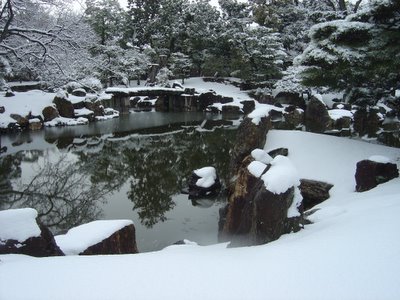
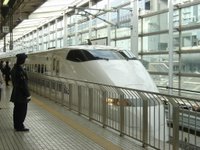
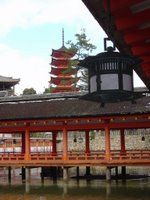
The lesson learned in the week before Christmas was that underestimating the speed with which the Japanese function, and the accuracy of their work, has consequences. With son Scott arriving on December 17, we set out on Dec. 19 aboard the Shinkansen, the fabled Bullet Train. At seven minutes before our scheduled departure time, a Shinkansen pulled into the station. I asked the platform manager in Japanese if this was the train for Shin-Osaka; it was. Thus, we three hustled aboard and walked the length of the car, only to find people in our assigned seats. Producing our tickets, they indicated that this was not the 'right' train. (It was really the Local Train to Shin-Osaka; not the express.). With this little mix-up now understood, we attempted to walk off the train, but only Scott managed to do so before the doors shut and the Shinkansen roared out of the station!
At this point you must understand two critical things; the Japanese Bullet Train is thus named not just for the cruising speed; - its station stops along the way can be between 30 – 60 seconds long. NO room for error, here. [We also keep getting caught at elevators – when the doors open you have maybe 3 seconds to pile in before its outta here!] Secondly, when the schedule says the train leaves at 10:37 am, IT WILL! Not one minute before, or two minutes after. This also means that it will only arrive in the station at 10:36!. Now we had to make our ways to Hiroshima separately.
The Shinkansen is a fast, comfortable and entirely civilized ride; it has big oval windows, enveloping airline style seating (but not Cabbage Class seating density), and the opportunity to enjoy food, drink and entertainment as the scenery flies by smoothly. While not taking the super-express Niozomi Shinkansen [Niozomi – the very word breaths speed, doesn't it?), we still arrived in Hiroshima about 5.5 hours later, despite some weather issues and having to change trains twice.
At Hiroshima station we boarded the local tram and clunked down to our hotel in the heart of the city. You will recall that Hiroshima was the unfortunate site of the dropping of the first A-Bomb 60 years ago – our hotel was two blocks from the hypo-centre. Arriving at the hotel, we then experienced two more entirely satsifying components of Japanese culture; there is NO tipping, and all prices include their 5% national tax. Thus, the fee for the item is what you actually pay! All of those irritating administration fees, user charges, disposal surcharges, GST, PST, MSG, NSF, whatever, do not magically appear when it comes time to pay up. Think about that the next time you take an airline flight, or check into a hotel! And we think Western civilization is advanced!
The next morn
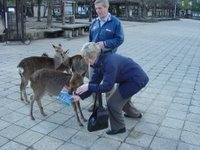 ing we were off to the island just offshore, named Miyajima, which is a legendary tourist site repleat with shrines, pagodas, temples and the natural beauty of Japan. Welcoming us at the ferry dock on the island were about 25 tame deer that roam the island freely, safe from predators. Unfortunately, upon learning that we had no food for them, one of the little blighters promptly snatched
ing we were off to the island just offshore, named Miyajima, which is a legendary tourist site repleat with shrines, pagodas, temples and the natural beauty of Japan. Welcoming us at the ferry dock on the island were about 25 tame deer that roam the island freely, safe from predators. Unfortunately, upon learning that we had no food for them, one of the little blighters promptly snatched  and ate Jean's tour map, so we were forced to wing it from there. The island is full of remarkable sites, the most prominent of which is the O-torii Gate in the water offshore; which welcomes visitors. That evening we struggled to order supper in Japanese in a Noodle Shop where no English was understood and then walked about taking photos of the city lights decorating the trees and bushes downtown.
and ate Jean's tour map, so we were forced to wing it from there. The island is full of remarkable sites, the most prominent of which is the O-torii Gate in the water offshore; which welcomes visitors. That evening we struggled to order supper in Japanese in a Noodle Shop where no English was understood and then walked about taking photos of the city lights decorating the trees and bushes downtown.The next day we walked over to the Peace Park, which is on the island in downtown Hiroshima that was the aiming point for the bomb. We photographed the A-Bomb Dome; the remains of a large building left standing as a memorial to those who died, and then spent some 3 hours going through the excellent museum there. We left depressed at the thought of this beautiful city being levelled and the kind and generous people who were normal citizens being killed, but this was a new kind of deadly war.
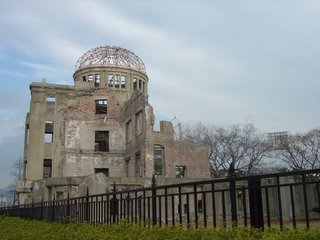 In the late afternoon we took the Shinkansen to Kyoto, where we celebrated our 32nd Wedding anniversary with a formal (and authentic) Chinese Dinner at the Hotel, courtesy of our son, Scott. (we thought we were handling the thing reasonably well until the staff started laughing at the fact that the chopsticks were being held upside down!) Every course, and there were five of them, came with its own complete service, and a particular way of eating the offering. Oishii!! {Delicious}
In the late afternoon we took the Shinkansen to Kyoto, where we celebrated our 32nd Wedding anniversary with a formal (and authentic) Chinese Dinner at the Hotel, courtesy of our son, Scott. (we thought we were handling the thing reasonably well until the staff started laughing at the fact that the chopsticks were being held upside down!) Every course, and there were five of them, came with its own complete service, and a particular way of eating the offering. Oishii!! {Delicious}The next day we awoke to find that we were 'lucky', (as the staff pointed out), to have the biggest snow-dump in over 20 years! This provided the backdrop for tours over the next two days of temples, shrines, the Imperial Palace, (Kyoto was for a long time the capital of Japan), and castles. In between we sampled local fare, scoured local shops, successfully learned how the beer vending machine works, and caught our first close glimpse of hotel living Japanese style – slippers at the door, fresh folded Kimonos on the bed, choice of Western or Japanese Style baths, (more on that later), the mobile pant-presser in the hall-way, ice costs extra if you want it, tooth brushes and toothpase always provided, the rooms are ALWAYS hot (usually 25 – 27 degrees, and when we left the window open to cool it to a bone-chilling 23 degrees the staff thought we were polar bears), a hot-pot of water stands by (to make tea or coffee anytime), and pillows have one end soft and the other firm so you always get the 'feel' you like and deserve! A free breakfast also gave us hints of the very different tastes of Japanese breakfasts – tomato-paste in steamed white buns, some type of rice wrapped in seaweed, fresh cabbage salads, fish, tofu, and miso soup.Best of all, many pastries, including cinnamon buns, doughnuts and chocolate bread sticks. Also, midorio ochea [green tea].
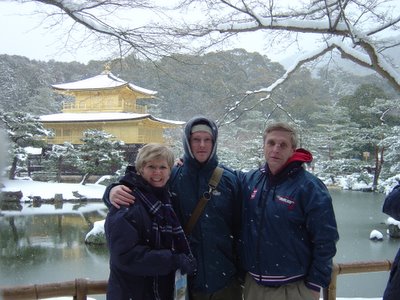
The highlite of the entire trip had to be the Golden Palace in Kyoto; a gold-leaf foiled temple surrounded by a small pond. Breat-takingly beautiful. On 24 December we took the train back to Shinagawa, where we met up with Della, who had flown in from Toronto. December 23 is the national holiday here; the Emporer's Birthday. Christmas in Japan is for lovers, so there were many weddings and clebrations in all of the downtown hotels going on at the time. People in the shops were dressed up, (a Frog and a Panda are popular, but the local store featured staff in a Reindeer and a female c
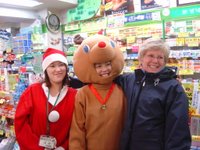 lerk in a Santa Suit), and most wished us a Merry Christmas.
lerk in a Santa Suit), and most wished us a Merry Christmas.We had a traditional Christmas; the exchange of gifts, a full turkey dinner with gravy, mashed potatos, stuffing, and pumpkin pie. Sandra and Jay celebrated not just with the Rollins family, but also a fellow pilot, Glenn, his wife Shirley, and their son, Brian. That evening, two Japanese flight attendants dropped over for a visit and were facinated by the Christmas traditions that we take for granted. I tried explaining how Christmas Stockings work, but that seemed a difficult concept for them. They closely examined all of the Christmas decorations with exclamations an
 d admiration, and even sampled an array of treats such as shortbreads, christmas cake, mince meat and butter tarts. While not all were to their taste, they were very curious about the whole deal, and the Rockin' Xmas Tree with the Santa Hat from the 100 Yen Store that plays Holly Jolly Christmas was a big hit.
d admiration, and even sampled an array of treats such as shortbreads, christmas cake, mince meat and butter tarts. While not all were to their taste, they were very curious about the whole deal, and the Rockin' Xmas Tree with the Santa Hat from the 100 Yen Store that plays Holly Jolly Christmas was a big hit.Learned along the Way; - (besides the truths revealled above).
- Four is an unlucky number – never buy four of anything. The photo at the right shows this susperstition at play. Slices of bread always come with no crust in packages of 6 or 8 slices. An attempt to introduce a smaller, 4-slice size failed due to the above su
 perstition. Viola! The 5-slice economy-sized package!;
perstition. Viola! The 5-slice economy-sized package!; - always ride the escalator on the extreme left so people in a hurry can get by;
- to get onto a really crowded subway train, just turn around on the platform, back up to the door, reach up with both hands to the rim above the inside of the door, push with all of your might and lever yourself into the carriage so the doors can close;
- How the Pachinko Palace Scam works – gambling is illegal, so you trade any steel balls that you win (I have yet to figure out how you actually win) on the spot for small stuffed animal 'prizes' – which is legal. Somewhere close in the neighborhood is a single window where you can then exhange the stuffed animals for varying amounts of hard cash;
- plastic shopping bags are really easy to carry if you clip on one of these handy plastic handles, which are available free of charge from the local supermarket checkout counter;
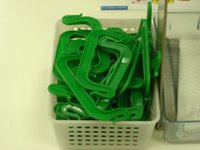
- Do not lean on the door at the front of the subway car; the conductor on the other side will not be happy when he is unable to get into the carriage to make his necessary station announcements, and when he gets frusterated, stepping aside suddenly will cause him to make a completely undignified entrance into the carriage.. Loss of 'face' (both physical and social), is not good.
Doug-San In Japan saying 'Sayonara' for now.

0 Comments:
Post a Comment
<< Home